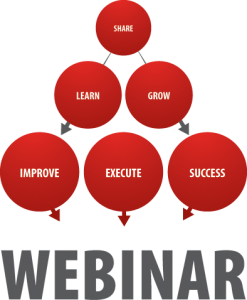 To kick your content strategy up a notch, a webinar is very effective in demonstrating your expertise and promoting a company’s technical knowledge. It generates fantastic exposure when used with various free marketing tools such as your social media, website and email marketing. Similar to a seminar, a webinar is an online medium to present information to a discerning audience. They are extremely popular nowadays as they eliminate heavy costs such as travel and venue that were traditionally associated with seminars. Sharing your technical knowledge is a subtle yet effective way of engaging with your target audience, where you can quickly establish your company as experts in your field.
To kick your content strategy up a notch, a webinar is very effective in demonstrating your expertise and promoting a company’s technical knowledge. It generates fantastic exposure when used with various free marketing tools such as your social media, website and email marketing. Similar to a seminar, a webinar is an online medium to present information to a discerning audience. They are extremely popular nowadays as they eliminate heavy costs such as travel and venue that were traditionally associated with seminars. Sharing your technical knowledge is a subtle yet effective way of engaging with your target audience, where you can quickly establish your company as experts in your field.
The success of any webinar is based on good planning and seamless execution. Here is a list of 11 considerations that you should closely evaluate before you embark.
1. The Webinar Tool
You need to spend time considering what webinar tool you are going to use. Many basic packages only accommodate a maximum of 25 people so it’s important to envision the scale of your event and what you expect from it. Evaluate each tool under price, number of participants and the features you may want such as a recording option, download the attendee list and so forth. Once you invest in a particular tool it is harder to change as you’ll find you are used to the functionality and less likely to learn a new one. Many webinar tools offer a 30 day trial so it is well worth trying this out first to see if you like its functionality and its features. Some popular Webinar tools to consider are:
• Go to Meeting: http://www.gotomeeting.ie/fec/
• Join Me: https://join.me/
• GatherPlace: http://www.gatherplace.com
• Webex: http://www.webex.com/
2. The Topic


3. The Planning
With any webinar you host, whether it’s your 1st or your 21st ensure every detail is well planned in advance and you are ready for the webinar on the day. Fail to plan, plan to fail, as a poorly executed webinar can damage your brand and image of your company. Along with a strong promotional plan, you must be ready to pull it off on the day so schedule a few dry runs in advance. You would be amazed at the minor details you are not aware of. While putting your presentation together finish with a strong call to action so people know exactly where to go should they require further information.
4. The Message


• Who is the presenter? Give a brief bio on their experience and qualifications.
• Who is your audience? Identify who the webinar is aimed at to eliminate any doubts.
• What is the webinar about? List the topics it will feature and a basic agenda.
• When is it taking place? Specify clearly the day, date, time and time zone if you’re targeting internationally. Wednesday/Thursday at 2pm is a good time for a European audience but if you are targeting Stateside you need to set accordingly.
• Where is it taking place? Once they are signed up, you can send a link to the webinar and explain that all you need is a computer, speaker and headphones if required.
• Why should I attend? You need to demonstrate the value in attending. What’s in it for me? What should people learn from the webinar?
• How long will it be? I think keep it to an hour to ensure maximum engagement.
5. The Sign Up
On all your webinar promotions, the most prominent call to action should be REGISTER HERE. Create a landing page on your website and have a straight forward sign up form. Requesting too many details will lead to abandoned forms.
• *First Name
• *Last Name
• Job Role
• Company Name
Once a form is submitted you can generate a thank you email with the link to the webinar or at least a message saying you’ll be in touch nearer the time.
For conversion purposes, I would also recommend that a goal is set up in Google Analytics to track that particular event. This is pretty straight forward, assuming you have Google Analytics, go to your Google Analytics standard reports, click on the ‘admin’ button, click ‘Goals’, click ‘+ Goals’.
Select the type of Goal that you are setting up, in this case ‘URL Destination’ for Thank you page after the Webinar. If you do not have a thank you page I recommend that you set one up, so on completion of the webinar sign up, users are brought to the thank you page.
If you are using Google Adwords for your webinars you can also add the conversion tracking from Adwords to this page to track conversions from any Google Adwords campaigns you set up.
6. The Promotion
Now that you’ve summarised your message and created your landing page you’re ready to start promoting. You should give yourself at least 4 weeks to promote the event. It’s a good idea to measure your marketing promotion to evaluate what’s working and what isn’t so you can tweak accordingly. Depending on your budget you should consider the following promotional tools.
• Email Marketing
This is where a well maintained CRM steps up the mark. Using your email marketing tool send an email announcement to your list of customers and prospects. If you have a good list and a great topic this should generate the majority of your sign ups. Send an email every week leading up to the event but remove those that have signed up to the webinar to avoid opt outs.
• Social Media Distribution
Using your Linked in, Facebook or Twitter account, share your newsletter or your sign up page every week.
• Email Signature
Ensure everyone in the company promotes the webinar and a link to the sign up page on your email signature.
• Sales Team
Encourage your sales team to highlight the event to customers or prospects and provide them with an A4 flyer to send via email or leave after meetings.
• Blog about your topic
Whet their appetite and prepare a brief blog on what the webinar is about. This can be shared via social media and website to amplify promotion.
• Press release
If you have good contacts with trade journalists, write a press release and ask them to feature it on their website or provide an endorsement on their social media.
• Online Advertising
As your promotion will run for a few weeks it is worth considering online advertising for people who are not aware of you. These can be very effective as they are targeted at specific search terms or specific job title/industry related to your webinar and topic.
- PPC
- Linked In Ads
- Facebook Ads
- Banner Ads in Trade Media
7. The Reminder


8. The Fee €€€
€€€ To fee or not to fee? While webinars can demand resources from your team, the benefits are far better than any advertisement you would take out in a publication. See it as a promotional tool and avoid charging. If it’s a technical topic it is more likely to attract a much targeted audience and the long term gain of this far outweighs slapping a €100 fee on it.
9. The Dress Rehearsal
You don’t have to be suited and booted unless you opt for a video webinar but several rehearsals beforehand are a must. The presenter must be able to use the webinar tool and dry runs are the only way to confidently do this. A week or 2 before the webinar, schedule a few dry runs with members of your team so you are confident on the day.
10. The Execution
On the day of the webinar, sign in a few hours before if you can and test audio, sound and various functions you may use. Then approximately an hour before the webinar test again and at this stage you can keep the meeting open to allow others to sign in in advance. Start the webinar on time no matter how many have signed in and it’s a good idea to mute participants on entry to avoid any disruptions thereafter. To ensure a seamless running, keep questions to the end of the webinar where you can use this as an opportunity to engage with people yet not waste time for those that need to sign out.
11. The Follow up


For more information on webinars contact [email protected] at IMS Marketing.
